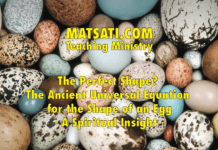In this weeks double portion from Parshiot Tazria/Metzora (Vayikra / Leviticus 12:1-15:33) the Lord speaks to Moshe on the topic of uncleanness. When a woman gives birth she will be unclean for seven days similar to the days of her menstruation (12:1-2). The eighth day the child is to be circumcised (12:4). Following the birth of a boy, the woman is to remain in the blood of her purification for thirty days and she is not to touch any consecrated thing nor enter into the sanctuary until the days of her purification are complete (12:4). For the female child she will be unclean for two weeks and remain in the blood of her purification for two months (60 days). After this time, the woman is to bring a young lamb as an Olah Korban (Whole burnt offering) before the Lord and this is used to cleanse her for the flow of her blood. If she cannot afford the lamb, she is to bring two turtle doves or two pigeons for a sin offering (12:5-8). Then the Scriptures speak saying the Priest is to inspect the person showing the signs of Tzaraat (13:1-46). The person found to have Tzaraat then is to remain outside of the camp and the Scriptures say 13:45 ‘As for the leper who has the infection, his clothes shall be torn, and the hair of his head shall be uncovered, and he shall cover his mustache and cry, ‘Unclean! Unclean!’ 13:46 ‘He shall remain unclean all the days during which he has the infection; he is unclean. He shall live alone; his dwelling shall be outside the camp. (NASB) The Lord goes on stating that a garment (wool, linen, or leather) is also able to contract Tzaraat (13:47). These linen garments are quarantined for seven days and reexamined to see if the Tzaraat is spreading. This most likely is a fungal mold that may be very hazardous to our health. If the garment is found to contain Tzaraat it is to be burned with fire (13:51-52). When the priest looks and the Tzaraat in the garment has not spread, the garment is washed and if the spot remains, the garment is to be declared unclean and it is to be burned with fire. If the mark is faded after washing, the mark is to be torn out of the garment, washed a second time, and inspected to be certain the Tzaraat has not reappeared in the garment (13:56-59). According to the Scriptures, the garment is to be carefully inspected.
כתבי הקודש / The Holy Scriptures
ספר ויקרא פרק יג
מח אוֹ בִשְׁתִי אוֹ בְעֵרֶב לַפִּשְׁתִּים וְלַצָּמֶר אוֹ בְעוֹר אוֹ בְּכָל-מְלֶאכֶת עוֹר: מט וְהָיָה הַנֶּגַע יְרַקְרַק | אוֹ אֲדַמְדָּם בַּבֶּגֶד אוֹ בָעוֹר אוֹ-בַשְּׁתִי אוֹ-בָעֵרֶב אוֹ בְכָל-כְּלִי-עוֹר נֶגַע צָרַעַת הוּא וְהָרְאָה אֶת-הַכֹּהֵן:
Vayikra / Leviticus 13:48-49
13:48 whether in warp or woof, of linen or of wool, whether in leather or in any article made of leather, 13:49 if the mark is greenish or reddish in the garment or in the leather, or in the warp or in the woof, or in any article of leather, it is a leprous mark and shall be shown to the priest. (NASB)
Studying the text very carefully, the Scriptures say מח אוֹ בִשְׁתִי אוֹ בְעֵרֶב לַפִּשְׁתִּים וְלַצָּמֶר אוֹ בְעוֹר אוֹ בְּכָל-מְלֶאכֶת עוֹר: where the word בִשְׁתִי may be translated as “to lay the foundation, fix the warp, start the loom,” and “to weave, in the mixture of the flax” according to Marcus Jastrow lexicon (A Dictionary of the Targumim, the Talmud Babli and Yerushlami, and the Midrashic Literature), in addition to this, the scripture describes the job of the priest to inspect the “boundary or border” (בְעֵרֶב לַפִּשְׁתִּים), the “wool, fleece, pelage” (וְלַצָּמֶר), “in the skin” (בְעוֹר), and “in all the work of the skin” (אוֹ בְּכָל-מְלֶאכֶת עוֹר). According to Vayikra / Leviticus 13:48, the priest inspects down to the very foundation of the clothing, the connecting materials, the flax, the wool, the manufacturing, and the weaving of the linens that make up the garment. Inspection for the disease (Tzaraat/Leprosy) is to be very meticulous. Studying these Scriptures on Tzaraat in linen garments, and the seriousness of the disease, calls us to inspect our lives were hidden sin may lay as a foundation of rottenness making us unclean before the Lord. According to the Scriptures only the Priest could diagnose Tzaraat. The reason being, Tzaraat was a spiritual malady that required spiritual discernment to both diagnose and treat. When someone was found to have Tzaraat, they were forced to leave the community and undergo a period of mourning and Teshuvah (repentance). Before the leper is reintegrated into the community of believers, he must undergo inspection by the high priest, kept aside for seven days and then reexamined, and only then is the person cleansed and purified through the ashes of the Red Heifer (Vayikra / Leviticus chapter 14). In the Apostolic writings, Yeshua cleansed many lepers during the course of His ministry. Yeshua spoke with greater authority than Moshe (Matthew 5:21-48), and it was only God and His Messiah Yeshua who could heal one from Tzaraat. According to the Scriptures Yeshua laid down his life for ours, doing so to take away our Tsaraat (Uncleanness and Sin) the purpose was to make us righteous and holy before the author of life, the Lord God Almighty. Hallelujah! BTT_Parashat Tazria-Metzora-2013








